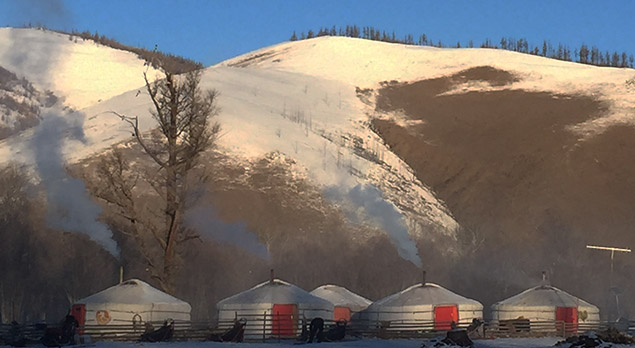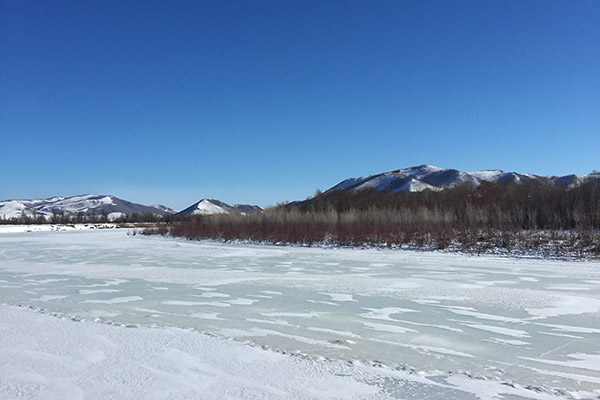Running The Genghis Khan Ice Marathon

Our adventure runner, Shona Thomson, tells us what it's like to run 26.2 miles along a frozen river in minus 40 degrees Celsius with local wildlife in the form of bears and wolves!
I stood at the start line somewhere in the plains of Outer Mongolia with eight other runners about to run a marathon along a route no one had ever stepped foot on before. Organised by expedition leaders, Sand-baggers, the Genghis Khan Ice Marathon was being run for the first time.
Runners came from all over the world for the inaugural event. The team included several other experienced polar runners, notably Doctor Andrew Murray (who went on to run 100 kms through the Mongolian wilderness just 24 hours later). Being a group of less than ten, there was a real sense that we should keep an eye out for each other on the route, rather than seeking to obliterate each other!
How did the expedition come about?
I got a text message from David Scott, Consul for Mongolia in Scotland, and owner of leading expedition company, Sandbaggers. The message read something along the lines of; I'm in London with Dr Andrew Murray and we want to convince you to do something. David was effectively the logistics behind the Namib550, which saw Andrew and his running partner, Donnie Campbell, run 550k across the Namib dessert in 50 degrees Celsius. Intrigued, and knowing this probably meant some equally crazy feat, I agreed to meet the boys in the pub, the place where all good adventures begin.
What was their proposal?
"A wee jog in Mongolia" were the words used if I recall correctly. After a bit more probing, the full extent of the expedition was revealed. David was organising the inaugural Genghis Khan Ice Marathon, a run of 26.2 miles in minus 40 degrees along the frozen river Tuul in Mongolia. There was no doubt it sounded incredible, running in the wilderness, with just a handful of other runners and men with huskies providing support. The week long adventure would also provide runners with the opportunity to play wild golf, trek and explore the amazing landscape.
Have you done anything like this before?
I’ve done a bit of running. I’ve run marathons at the North Pole and in Antarctica, as well as on every continent. I quite enjoy a bit of a challenge and adventure!
Did you say yes immediately?
No! I was incredibly excited about the trip and very happy to have been invited but I needed to think it through completely. After a bit of time I eventually came to the conclusion that I usually do; life is about experiences so why not give this challenge a shot?
What were you hoping to gain from the adventure?
I had several objectives for the trip. Primarily, I want to raise a lot of funding for Riding for the Disabled (RDA) and the Scottish Association of Mental Health (SAMH). In addition to running the marathon, I rode a Mongolian pony to help raise awareness RDA. I’ve not ridden for years so thankfully the pony had been broken in! I'm also wanted to experience a new culture and visit a country I might never have otherwise got to see. It was wonderful to see the beautiful landscapes on the marathon course.
Tell us a little about the chosen charities
The two chosen charities are Riding for the Disabled (RDA) and Scottish Association of Mental Health (SAMH). It’s just amazing to see the happiness and sense of achievement that riding brings to so many adults and children with disabilities. SAMH is a fabulous charity too, which really emphasises the importance of physical activity in managing mental health issues. We are also doing some in country work, providing kit and medical equipment to the local communities.
How did you prepare mentally?
I'm sure I'm not alone in having unhelpful thoughts such as, “I'm not fast enough". However, comparing myself to other runners is guaranteed to take all joy I get from running. I've had countless setbacks, illnesses and injuries which makes it utterly pointless comparing my performance to anyone else's. I run for enjoyment, for my physical and mental health and as a way to see the world.
My main objectives were to experience something that was a world first and raise awareness and funds for our two charitable causes, Riding for the Disabled (RDA) and SAMH. I also had Tokyo marathon in late February so Mongolia was more of a cold training run than a race!
It can be easy to overthink challenges such as these but at the end of the day it is only an extremely cold run in Outer Mongolia! There are so many new variables for your body to cope with from the jet-lag to the food to staying in Gers with local nomads to the bitter cold. It is impossible to predict what will happen on the day or how your body will react to the cold. In some ways, these types of marathons are less pressure than conventional marathons as it is very hard to target a time when you're running in minus 40 degrees Celsius on ice. For me, the main competition is the conditions: the risk of frostbite, hypothermia and the local wolves!
What do you think it takes to complete a marathon like this one?
I think first and foremost it is about the team and support network. To undertake a run like this is not so much about ability, it's about mental attitude. It's about being open to new experiences, knowing it will be tough, knowing you won't be comfortable but being able to accept that is part of any great adventure. I think a lot of it is about just giving it a go and doing the best you can based on your own circumstances. These types of marathons are not about winning or about PBs, they are about the experience. I learned that at both the North Pole marathon and Antarctic Ice marathon!
Most importantly, it’s about having a sense of perspective. It is only a day of running in the (extreme) cold, which is nothing when you think about the challenges faced by the ill and disabled on a daily basis, like those for whom we are fundraising.
How do you prepare for a marathon like this?
One thing that is certain is that my training never goes according to plan! I had several health issues to manage in the run up. However, the important thing was to be on the start line even if preparation hadn't been ideal.
In terms of running preparation, I just trained as I would for any normal marathon. When I trained for both the polar marathons I didn’t do anything particularly different like running in a freezer! Having run in Antartica and the North Pole, I knew how intensely bone chillingly cold it would be so I decided there was no need to remind myself again before I went! Just as important, if not more important than the training, is getting the correct kit. There is a real risk of frostbite and hypothermia if you wear inappropriate clothing or pace yourself incorrectly on the run.
What kept you motivated to train through the winter?
A huge part of my motivation for doing this is to raise awareness and funds for our two chosen charities, Riding for the Disabled and SAMH. Having a cause greater than oneself is very important. It is always humbling to read stories about the challenges that many disabled people face and the incredible achievements so many gain through charities such as riding for the disabled. It puts a few cold runs into perspective.
What was Marathon Day like?Imagine waking up in Ger in the Mongolian wilderness. The temperature outside is minus 40 degrees Celsius, the winds are bracing, the ground hard with ice, yet the sun shines, reflecting off snow-capped mountains and sparkling on the frozen river. It is bleak but it is beautiful. This was the backdrop of our 26.2 mile run along the frozen river Tuul and winter wonderland of wooded trails.

It's much harder to breathe in such temperatures and there is always a danger of hypothermia and frostbite. I kept at a steady pace so that I could safely monitor my body, plus I was under under orders not to get my heart rate up due to my iron levels. My breathe froze on my balaclava and formed a frozen armour against my face. My eyes watered, creating crystal visors on my eyelashes. At times, I thought I was passing through Dante’s ninth circle of hell, frozen in the ice lake of Cocytus, as I became progressively encased in ice!
We were supported by huskies patrolling the course to ward off the wolves and bears in the area. Water turned to ice in minutes so staying hydrated was a real challenge.My gels became increasingly hard to swallow as they began to freeze. I also used up a few more than I normally would as my body worked to keep warm and deal with the underfoot terrain. I took a wrong turn at one point (as did several other runners) and headed out onto the vast plains. I felt the complete isolation and remoteness of the area. I’m not sure how much further I ended up running but I didn't mind as the landscape was just so breathtaking.
After several hours out in the Mongolian wilderness, I made it to the finishing point, at a local Nomad’s Ger. I was a bit bruised from taking a few tumbles on the ice. Probably the greatest damage was to my earlobes as I stupidly forgot to remove my earrings. They got quite severe frostbite which began to blister, bleed and turn black. However, the medics were top class and got me on antibiotics straight away.
Where did you staying during the trip?
Most nights we stayed in gers with local Mongolian families. It was a true wilderness experience in this respect. The gers were basic but cosy and comfortable. No showers, loos or wifi but welcoming and atmospheric!
What else was planned when you were out there?
The great thing about this trip is that there were several aspects to the adventure. The marathon was just part. I rode a Mongolian horse to raise awareness of the benefits of riding for the disabled. David Scott (from Sandbaggers) who organised the inaugural Genghis Khan ice marathon also had some plans lined up with the fifth Ulan Bator burns supper, as well as supporting local community initiatives. Lastly, and by no means least, Dr Andrew Murray forged some great golfing links with Mongolia and ran a solo 100 km run as well.
What support did you have out there?
I am very fortunate to have such great support. My family puts up with a lot! I owe a lot of thanks to David Scott at Sandbaggers and Doctor Andrew Murray for putting together the Genghis Khan Ice Marathon. I'm sponsored by Ellis Brigham Mountain Sports, who have been truly fantastic with their support. You can see the kit I wore here. I'm also hoping to do some fundraising talks in some of the Ellis Brigham stores about the trip upon my return.
Final Thoughts
The extreme cold dissuades many people from visiting Mongolia in winter. However, for those who brave the winter, the rewards are infinite. The land of the blue skies certainly didn't disappoint. The landscape takes on an extraordinary beauty in its winter raiment. With no other people in evidence, you feel you have the country to yourself. So would I return? Yes!






